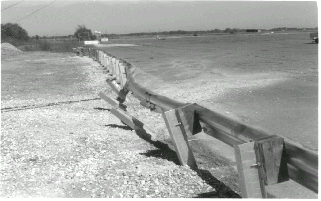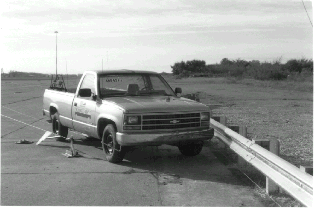
Full Scale Crash Tests to Evaluate New Guardrail Technology
The Federal Highway Administration (FHWA) recently conducted several crash tests on guardrails at the Texas Transportation Institute facilities. The design of the guardrail-to-bridge rail transition is critical in the effectiveness of the system and can save lives, particularly at high speed roadways and adverse horizontal and vertical alignment.
In the highway network of Puerto Rico have been installed many miles of guardrails due to the great extent of mountains in the island and steep slopes (3H:1V or steeper) in fill sections. The decision to warrant a barrier and the different types available in the market are documented in the Highway Design Manual of Puerto Rico and the 1996 AASHTO Roadside Design Manual.
Full
scale crash tests are used to evaluate the effectiveness of new guardrails and
the transition to the bridge parapet following the guidelines documented in
the report entitled NCHRP #350.
One of such test was performed on a transition design that consist of a W-beam rub rail. A second test was performed on a thrie beam guardrail with routed wood blockouts on 2.1m(6’9”) long steel posts.
A brief description of the test and the findings are summarized below:
In the w-beam rub rail, researchers determined, using computer simulation that the critical impact point was to be 1.5m (4’9”) from the end of the bridge concrete parapet. The 2000-kg pickup truck impacted the transition at 60 mph at an impact angle of 25 degrees. The pickup truck was redirected and remained upright. The test results met the evaluation criteria for Test Number 3-21 in NCHRP Report 350.
In the design used for this test, the upper and lower W-beam rails were connected to a vertical face on an independent concrete end block. The side of the concrete end block was shaped so that it would transition from a vertical section to a New Jersey-shape over a 3.05m (10’) length. This is a versatile transition design because it can be used to connect the guardrail to either a New Jersey-shape or a vertical concrete bridge rail. The independent concrete end block has a large spread footing, which can be eliminated if the end block is adequately attached to the wing wall abutment.
When conducting the test, it is important to properly lap the W-beam rails over the end shoes in the direction of traffic. In the earlier test, the end shoes were improperly lapped over the W-beam rails. As the result, the edges of the end shoes formed a snag point that caused the pickup truck to roll 45 degrees towards the barrier before coming to a complete stop.
In
the thrie beam guardrail with routed wood blockouts on 2.1m (6.9) long steel
posts the objective was to check whether this system could meet the strength
requirements for NCHRP #350 Test Level Three (TL-3). The major concern was whether
or not the steel post guardrail would perform satisfactorily because a thrie
beam on strong steel post guardrail (G9 System) with steel blockouts had previously
failed the same strength test with a pickup truck.
The thrie beam is connected to a 150-mm by 200-mm wood blockouts with a 100-mm by 10-mm routed groove. This groove fit over the steel flange and prevented rotation of the wood blockout. It also served to brace the flange against buckling until the vehicle was redirected. The 2000-kg pickup truck impacted the guardrail at a nominal impact speed of 60 mph and at angle of 25 degrees and was smoothly redirected. The pickup truck remained upright and relatively stable during and after the collision. The damage to the pickup truck was relatively minor as well as the damage to the guardrail.
The maximum lateral deflection of the barrier was 0.58m (1’9”) thus meeting the NCHRP 350 evaluation criteria.
For additional information regarding full scale crash tests on guardrails please contact:
Charles McDevitt
(202)493-3313
Adapted from: Research and Technlogy Transporter